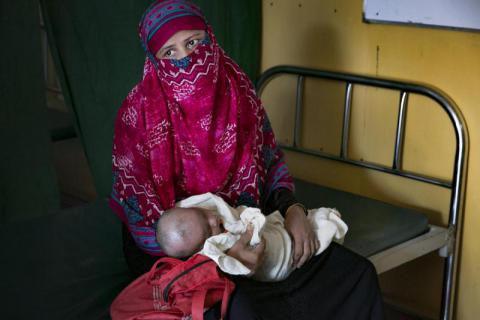An estimated 75 percent of Rohingya babies are born in the unsafe and unsanitary bamboo shelters in which refugees live, based on an assessment by Save the Children from Cox’s Bazar in Bangladesh. Home births in such conditions put the lives of both mother and baby at great risk. Save the Children is warning that hundreds of mothers and babies in the refugee camps could die this year of entirely preventable causes if mothers don’t get proper maternal healthcare.
Data from Save the Children’s Primary Health Care Centre (PHCC) from July 2018 to April 2019 shows that of the expected 400 births in a community of some 20,000 people[1], only 119 babies were safely delivered in Save the Children’s properly-equipped health facility, with the remaining births taking place at home.
Save the Children’s assessment comes as the UNFPA (United Nations Population Fund) and CDC (Center for Disease Control) jointly release new data from the Rohingya refugee camps, which estimates that for every 100,000 live births, 179 mothers die from preventable causes related to pregnancy and childbirth – almost two and half times higher than the worldwide target for maternal mortality of under 70 per 100,000 live births[2].
Worryingly, The UNFPA/CDC study also found that half of all maternal deaths in the camps happen at home. This means mothers received no emergency care which could have been life-saving. Save the Children has heard anecdotally that some families don’t seek out care during pregnancy complications because they fear sterilization or infanticide based on their experiences in Myanmar and would rather keep the woman at home at all costs. Health care providers need to earn the trust of this community so that expectant mothers get the care they need when they need it.
Home births put the lives of both mother and baby at serious risk, as unskilled birth attendants are often unable to identify or handle emergencies in time, and are unaware of pre-existing conditions with the mothers such as high blood pressure, diabetes, anemia and malnutrition, which can lead to complications during delivery. Also, poor hygiene practices can lead to severe infections for mothers and newborns.
The maternal mortality rate paints a grim picture of the unhygienic conditions in which many girls and women in the camps deliver their babies. It also shows that despite the availability of free antenatal, delivery and postnatal care, more work needs to be done to dismantle barriers and encourage expectant mothers and their families to access healthcare.
The circumstances in which mothers give birth in the Rohingya camps must improve rapidly in order to save lives. That is why Save the Children is calling for:
- Rapid investment to make high-quality health facilities available for expectant mothers and their families.
- Expectant mothers in the refugee camps to have access to proper antenatal, delivery and postnatal care.
- Further consultation with community leaders to address traditional practices that prevent pregnant women from seeking proper medical care.
30-year-old *Kortiza is a single Rohingya refugee mother who lives in a camp in Cox’s Bazar. All but one of her four children were delivered in the home. When she was pregnant with her youngest child, her husband left her. A few months later when she went into labor she was all alone with no one to help her.
*Kortiza told Save the Children:
“When I was giving birth to this baby, the pains were coming severely every 2-3 hours but I just couldn’t push. I was scared because I was alone and had no-one to help me with the birth. When I was pregnant here [in the camp], a woman from Save the Children was doing home visits. She told me about the facilities and the doctors at the clinic here and gave me a token and told me to come when it was time to give birth. I walked to Save the Children’s clinic from my home. It took me about 40 minutes with the pain. It might have been much longer for all I know.
“If I gave birth at home I had no midwife, no instruments to help, no-one to cut the cord, no-one to clean the place afterward. Now I would suggest to other mothers that they should use all of the services here. I would suggest the pre-natal also. I will use post-natal services – my baby will have vaccinations at three months and I will get her checked. I also know about family planning services to prevent pregnancies, these are good.”
Dr. Golam Rasul, Senior Health Programme Manager for Save the Children’s Rohingya Response, said:
“Kortiza’s story is not unique. Pregnant women in the refugee camps face tremendous challenges and barriers to accessing proper maternal and newborn care. Besides addressing the traditional practices that keep many Rohingya women in the home during and after the birth, we must invest in more specialized care for maternal complications and care for small, premature or sick newborn babies. This could help save hundreds of lives as this crisis becomes more protracted.”



